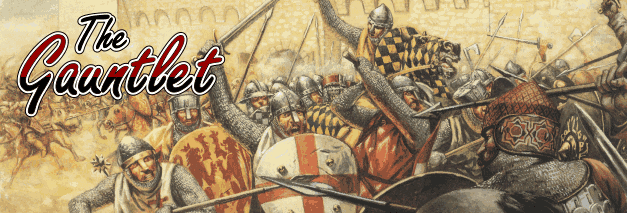
|

|
|
Archives of our Gauntlet Newsletter September 2017 - The last issue written by Mike Hamilton. Presented as text only for now. (Slightly edited by Rick Macmurchie) Some history of the symbolism and history of use of heraldic charges... THE ANCHOR: The Christian emblem of hope and refuge; awarded to sea warriors for special feats performed; the Greeks and Romans considered to the anchor as sacred as it was always dedicated to some god. The anchor was given to Clement of Rome and Nicolas of Bari. Nicolas of Bari is the patron saint of sailors. Also signifies steadfastness and stability. In seafaring nations, the anchor is a symbol of good luck, of safety, and of security, and thus of trust and confidence. THE ANNULET: The emblem of fidelity; a ring worn as a sign of Knighthood (Roman)...it stood as the symbol of nobility and jurisdiction, and was the gage of royal favour and protection; also a mark of Cadency of the fifth son. Commonly called in Latin, Annulus, but by Cambden, Annellm, which perhaps he took from the French, Annelet, for so they call them. And Colomliere speaks of them thus: The hieroglyphic of the ring is very various [sic]; some of the ancients made it to denote servitude, alleging, that the Bridegroom uses to give it to his Bride, to denote to her that she is to be subject to him, which Pythagoras seemed to confirm, when he prohibited wearing a Ring, that is, (implying) not to submit to over rigid Servitude. Many believe the Rings do, rather, denote the Truth and Fidelity they owe to one another, than that they denote any Servitude. The Romans by the Ring represented Liberty and Nobility, and none among them were allowed to wear it but such as were of their Knightly Degree, and Soldiers of Renown. A Ring may also signify Secrecy, especially if it have a Seal cut on it: and it may be the Emblem of Love, if the Face, the Cypher, or the Arms of the Person beloved are engraved on it. The Ring also denotes Strength. by reason of its circular Figure; so that this Figure is graceful and of great Signification. THE ANTELOPE: The word comes from Medieval Latin anthalopus and from Late Greek antholops. It was only the Egyptian elite who were allowed to hunt various species of Antelope and Ibex and considered them magical, and even had amulets made in their shapes. In Heraldry, Antelopes seem to appear more often in the arms of royalty but not exclusively so. The symbol represents action, agility and sacrifice and a very worthy guardian that is not easily provoked, but can be fierce when challenged. In Sumerian mythology, the antelope was both a lunar and solar animal. As a solar creature it was sacred to the god Ea who was sometimes called Ea-Onnes ("the antelope of Apsu and of creation") and the god Marduk. In its lunar form the antelope or gazelle was sacred to the Goddess Astarte. In Egyptian Lore, this animal represented Osiris and Horus, but was also sacred to the Goddess Isis and it was sacrificed to the desert god Set. In most of Asia Minor the antelope was considered to be a lunar animal and associated with the Great Mother In India it was an emblem of Shive, the chariots of Chandra. |
|
|
--
|
|
|
Copyright © 2001-2025 - Armorial Gold Heraldry Services. |